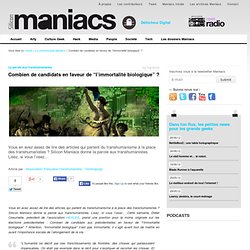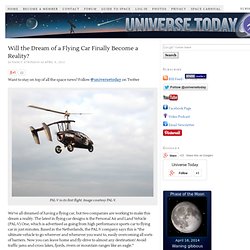

News - Self-sculpting sand robots are under development at MIT. 3 April 2012Last updated at 13:46 ET The MIT team have built test modules with microprocessors and magnets to prove their theory Tiny robots that can join together to form functional tools and then split apart again after use might be ready for market in little more than a decade, according to researchers.

A team at the Massachusetts Institute of Technology says it has developed about 30 prototype "smart pebbles" and the software to run them. The sides of each cube are 1cm (0.4 inches) in length. Efforts are now focused on creating smaller models. The researchers from the university's Distributed Robotics Laboratory liken the ultimate product they are trying to develop to "self-sculpting sand". "We want to have a bag of this material that can form any shape you demand," PhD student Kyle Gilpin told the BBC.
Destroying Mercury To Build A Dyson Sphere Is A Bad Idea. Combien de candidats en faveur de “l’immortalité biologique” ? Vous en avez assez de lire des articles qui parlent du transhumanisme à la place des transhumanistes ?

Silicon Maniacs donne la parole aux transhumanistes. Lisez, si vous l’osez… Cette semaine, Didier Coeurnelle, président de l’association HEALES, prend une position pour le moins originale sur les élections présidentielles : Combien de candidats aux présidentielles en faveur de “l’immortalité biologique” ? Attention, “immortalité biologique” n’est pas immortalité, il s’agit avant tout de mettre en avant l’importance sociale de l’allongement de la vie. “L’humanité se décrit par ses franchissements de frontière, des choses qui paraissaient impensables. On était par exemple dans le récit pour s’expliquer et raconter les choses. Voici ce que déclarait Jean-Luc Mélenchon, le candidat du front de gauche aux présidentielles le 12 janvier 2012 au cours de sa longue et, selon beaucoup brillante, prestation durant l’émission “Des paroles et des actes”.
News - Can computers have true artificial intelligence? 2 April 2012Last updated at 19:03 ET Professor Owen Holland explains how the world's first anthropomimetic robot works Is it possible to create true artificial intelligence and, if so, how close are we to doing so, asks mathematician Professor Marcus du Sautoy.

It was while I was making my last BBC TV series, The Code, that I bumped into a neuroscientist I knew. "Have you heard the news about Watson? " Printable Robots: MIT Project Wants to Let You Design and Fabricate Your Own Machines. An insect-like robot designed and printed using new fabrication techniques developed by MIT researchers.

Photo: Jason Dorfman, CSAIL/MIT Who knew that origami could be the future of robotics? Today, if you want to design and build your own robot, you have to order components, write software, and then assemble and test your creation. Of course, the more sophisticated your robot gets, the more time and money you have to spend on it. Vladimir Putin Confirms Russian Zombie Radiation Gun. High-Flying Turbine Blimps Could Cut Wind Electricity Costs By 65 Percent.
Researchers create incredibly thin solar cells flexible enough to wrap around a human hair. Will the Dream of a Flying Car Finally Become a Reality? Want to stay on top of all the space news?

Un écran flexible pour livre électronique chez LG. Google Gets Transparent with Glass, Its Augmented Reality Project. Larry Page and Sergey Brin have long had the dream of a hands-free, mobile Google, where search was a seamless process as you moved around the world.

As the years progressed the vision did, too, expanding beyond search to persistent connections with the people in your lives. In other words, Google’s view of the world now has the social side fully baked into it. Today, Google is revealing that it is taking concrete steps towards that vision with ProjectGlass, an augmented reality system that will give users the full range of activities performed with a smart phone — without the smart phone. 'Epidermal electronics' tattoos: a giant step forward for cyborgs. The latest patch developed by Dr Rogers’s team can both measure muscle activity and stimulate those muscles so they could be used for rehabilitation.

But Dr Rogers envisages broader applications – from monitoring sporting performance to seeing how hydrated your skin is with solar-powered epidermal electronics. Which brings us back to Edgar Allan Poe. In an 1839 short story, The Man That Was Used Up, Poe told the tale of a wounded soldier whose body was rebuilt using synthetic parts, including the “handsomest pair of whiskers under the sun”.
Watch "smart sand" figure out how to perfectly copy an object. New Surveillance System Identifies Your Face By Searching Through 36 Million Images Per Second. When it comes to surveillance, your face may now be your biggest liability.

Privacy advocates, brace yourselves – the search capabilities of the latest surveillance technology is nightmare fuel. Hitachi Kokusai Electric recently demonstrated the development of a surveillance camera system capable of searching through 36 million images per second to match a person’s face taken from a mobile phone or captured by surveillance. While the minimum resolution required for a match is 40 x 40 pixels, the facial recognition software allows a variance in the position of the person’s head, such that someone can be turned away from the camera horizontally or vertically by 30 degrees and it can still make a match.
Furthermore, the software identifies faces in surveillance video as it is recorded, meaning that users can immediately watch before and after recorded footage from the timepoint. The power of the search capabilities is in the algorithms that group similar faces together. AI robot: how machine intelligence is evolving. Marcus du Sautoy with one of Luc Steels's language-making robots.

Photograph: Jodie Adams/BBC 'I propose to consider the question "Can machines think? "' Not my question but the opening of Alan Turing's seminal 1950 paper which is generally regarded as the catalyst for the modern quest to create artificial intelligence.